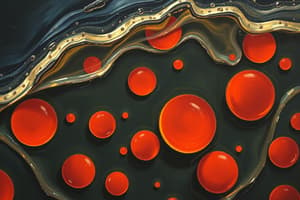Podcast
Questions and Answers
What is the unique property of the cell membrane that helps it to adapt to different temperatures?
What is the unique property of the cell membrane that helps it to adapt to different temperatures?
- Membrane permeability
- Membrane fluidity (correct)
- Cell wall formation
- Protein synthesis
What are the three main factors that affect membrane fluidity?
What are the three main factors that affect membrane fluidity?
- Temperature, pH, and light
- Temperature, cholesterol, and fatty acid type (correct)
- Oxygen levels, pressure, and humidity
- Cell size, cell shape, and cell division
What is the state of phospholipids in the cell membrane at extremely low temperatures?
What is the state of phospholipids in the cell membrane at extremely low temperatures?
- Crystallized state (correct)
- Gas state
- Liquid state
- Solid state
What happens to the distance between phospholipids in the cell membrane as the temperature increases?
What happens to the distance between phospholipids in the cell membrane as the temperature increases?
What type of fatty acid chains in phospholipids would increase membrane fluidity?
What type of fatty acid chains in phospholipids would increase membrane fluidity?
What is the effect of low temperatures on membrane fluidity?
What is the effect of low temperatures on membrane fluidity?
What is the main component of the cell membrane that we are focusing on in this video?
What is the main component of the cell membrane that we are focusing on in this video?
Why do phospholipids cluster together at low temperatures?
Why do phospholipids cluster together at low temperatures?
What happens to the distance between phospholipids when unsaturated fatty acids are present?
What happens to the distance between phospholipids when unsaturated fatty acids are present?
How does cholesterol affect membrane fluidity at low temperatures?
How does cholesterol affect membrane fluidity at low temperatures?
What is the effect of increasing temperature on membrane fluidity?
What is the effect of increasing temperature on membrane fluidity?
Why do unsaturated fatty acids increase membrane fluidity?
Why do unsaturated fatty acids increase membrane fluidity?
What is the result of having a high concentration of saturated fatty acids in a cell membrane?
What is the result of having a high concentration of saturated fatty acids in a cell membrane?
How many factors were mentioned as affecting membrane fluidity?
How many factors were mentioned as affecting membrane fluidity?
What happens to the distance between phospholipids as the temperature increases?
What happens to the distance between phospholipids as the temperature increases?
What is the effect of cholesterol on membrane fluidity at low temperatures?
What is the effect of cholesterol on membrane fluidity at low temperatures?
What is the effect of cholesterol on membrane fluidity at high temperatures?
What is the effect of cholesterol on membrane fluidity at high temperatures?
What is the role of cholesterol in maintaining membrane fluidity?
What is the role of cholesterol in maintaining membrane fluidity?
How do saturated fatty acid chains differ from unsaturated fatty acid chains?
How do saturated fatty acid chains differ from unsaturated fatty acid chains?
How do unsaturated fatty acid chains interact with each other compared to saturated fatty acid chains?
How do unsaturated fatty acid chains interact with each other compared to saturated fatty acid chains?
What is the effect of unsaturated fatty acid chains on membrane fluidity?
What is the effect of unsaturated fatty acid chains on membrane fluidity?
Why do phospholipids cluster closely together at low temperatures?
Why do phospholipids cluster closely together at low temperatures?
What is the primary function of the phosphate head group in a phospholipid?
What is the primary function of the phosphate head group in a phospholipid?
What is the main difference between saturated and unsaturated fatty acid chains in terms of their structure?
What is the main difference between saturated and unsaturated fatty acid chains in terms of their structure?
Flashcards are hidden until you start studying
Study Notes
Cell Membrane Fluidity
- Cell membrane has a unique property called membrane fluidity, which is affected by three main factors: temperature, cholesterol, and fatty acid composition.
Temperature and Fluidity
- At low temperatures, phospholipids cluster together, reducing fluidity due to low energy levels.
- At high temperatures, phospholipids move apart, increasing fluidity due to higher energy levels.
- As temperature increases, fluidity also increases.
Cholesterol and Fluidity
- Cholesterol inserts itself between phospholipids, increasing the distance between them and increasing fluidity at low temperatures.
- At high temperatures, cholesterol causes phospholipids to come closer together, decreasing fluidity.
- Cholesterol acts as a buffer, increasing fluidity at low temperatures and decreasing fluidity at high temperatures, allowing the cell membrane to maintain a stable level of fluidity.
Fatty Acid Composition and Fluidity
- Phospholipids with saturated fatty acids have straight chains that stack together neatly, resulting in low fluidity.
- Phospholipids with unsaturated fatty acids have bent chains, resulting in more distance between them and increasing fluidity.
- Increasing the amount of unsaturated fatty acids in the cell membrane increases fluidity.
Studying That Suits You
Use AI to generate personalized quizzes and flashcards to suit your learning preferences.



